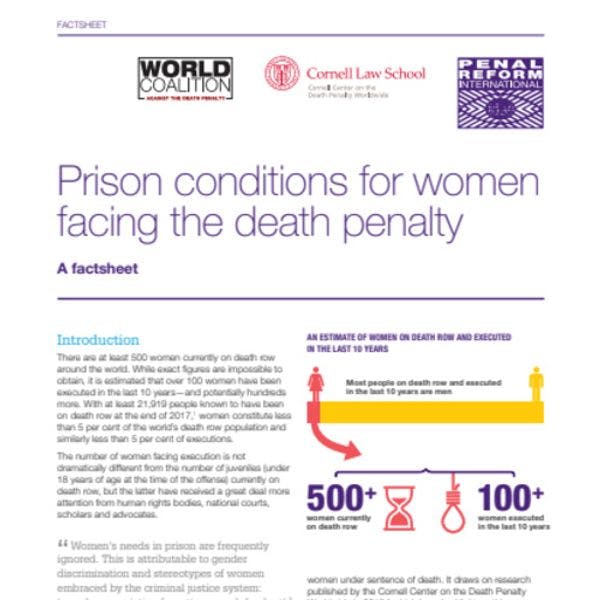Condiciones penitenciarias para las mujeres que se enfrentan a la pena de muerte
Este informe evalúa las condiciones inhumanas de las reclusas en el corredor de la muerte, destacando las violaciones generalizadas de los acuerdos y las normas internacionales. Más información, en inglés, está disponible abajo.
By World Coalition Against the Death Penalty, Cornell Law School and Penal Reform International
Living conditions on death row remain poor for both men and women; however, given that most facilities are designed with the majority male population in mind, the unique needs and vulnerabilities of women are overlooked. In countries that do not execute women, the prolonged length of their death sentences means that poor conditions have a disproportionate impact on their physical and mental well-being. Women serving death sentences are vulnerable to violence, particularly in prisons where male staff supervise them, or where prison authorities fail to protect them from violence at the hands of other prisoners. For example, in China, women prisoners (like their male counterparts) suffer at the hands of ‘cell trustees’, who control their cellmates through abusive means, sometimes leading to deaths.
Women’s vulnerability, due to gender and social norms, means that they often seek protection from staff or other female prisoners. In some cases, for instance in Tanzania, predatory and arguably coercive ‘relationships’ ensue, and women on death row may even be required to perform sexual acts to receive basic necessities, such as food. In Sierra Leone, there are reports that prison guards and other prisoners abuse female prisoners with mental health disorders.
Shackling death row prisoners is common in some countries, for instance in China where shackles are used at all times (on hands and feet). There have been reports that children are required to help shackled women eat, illustrating the impacts of this humiliating and unnecessary practice. Despite the Bangkok Rules prohibiting the use of restraints on women who are pregnant, during labor or after birth, in Sudan a death row woman prisoner was shackled to heavy chains in prison while eight months pregnant and caring for a young child, and during childbirth.
Similarly, death row prisoners are frequently held in solitary confinement, either by virtue of their sentence or as a disciplinary sanction. Despite limitations set down in the Mandela Rules, prolonged solitary confinement (which is prohibited) for women and men on death row has been reported in China, Indonesia, Jordan, India and the United States.12 Evidence shows that solitary confinement brings unique harms and dangers to women prisoners. This is linked to the disproportionately high rates of mental illness and trauma from past abuse suffered by women in prison. Solitary confinement also restricts visits between a mother and her children, in effect punishing the children.
Prison overcrowding affects detention facilities globally, including female death row, resulting in a range of human rights violations and dangerously unhygienic conditions. In Thailand, for example, where female death row prisoners are held with the general prison population, cells are so crowded that women must take turns sleeping on the bare floor. In Malawi, some women must urinate or defecate in a bucket at night because the toilets outside the cells are inaccessible at nighttime. While this is also the case for men, such a lack of privacy brings disproportionate stigma on women and illustrates how the design of prison infrastructure can impact negatively on meeting women’s specific needs.
Prisons generally fail to provide women with female-specific healthcare and deprive them of necessary hygienic products. For those serving long terms in prison, healthcare needs become greater and more complex – including mental ill-health and complications from lack of hygiene – and particularly in overcrowded facilities or where health provision is lacking.
Descargas
Temas
Regiones
Perfiles relacionados
- Penal Reform International
- World Coalition Against the Death Penalty
